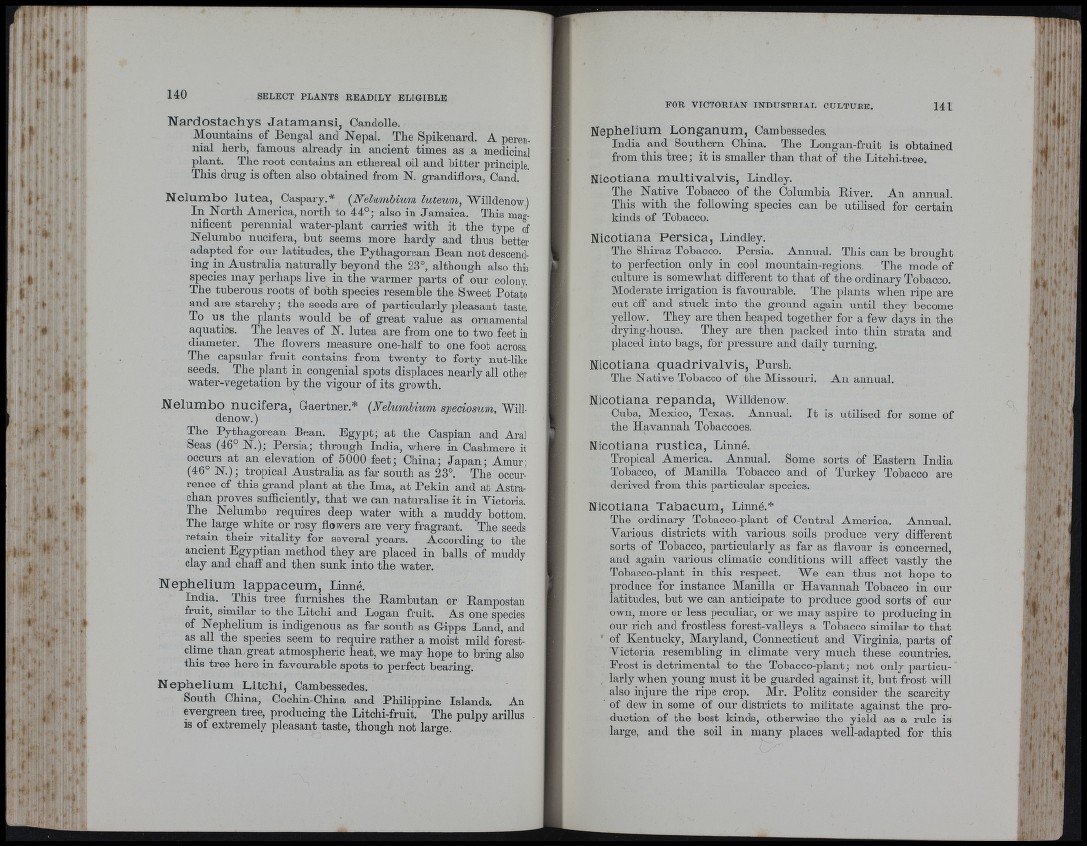
i f'
Nardostachys Jatamansi, Candolle.
Mountains of Bengal and Nepal. The Spikenard. A perennial
herb, famous already in ancient times as a medicinal
plant. The root contains an ethereal oil and bitter principle.
This drug is often also obtained from N. grandiflora, Cand.
Nelumbo lutea, Caspary.* {NelumUum luteum, Willdenow.)
In North America, north to 44°; also in Jamaica. This magnificent
perennial water-plant carries with it the type of
Nelumbo nucífera, but seems more hardy and thus better
adapted for our latitudes, tbe Pythagorean Bean not descending
in Australia naturally beyond tbe 23°, although also this
species may perhaps live in the warmer parts of our colony.
Tbe tuberous roots of both species resemble the Sweet Potato
and are starchy ; the seeds are of particularly pleasant taste.
To us the plants would be of great value as ornamental
aquatics. The leaves of N. lutea are from one to two feet in
diameter. Tbe flowers measure one-half to one foot across.
The capsular fruit contains from twenty to forty nut-lihe
seeds. The plant in congenial spots displaces nearly all other
water-vegetation by the vigour of its growth.
Nelumbo nucífera, Gaertner.* {Nelumbium speciosum, Willdenow.)
Tbe Pythagorean Bean. Egypt; at the Caspian and A-al
Seas (46° N.); Persia; through India, where in Cashmere it
occurs at an elevation of 5000 feet; China; Jap an ; Amur;
(46° N.); tropical Australia as far south as 23°. The occurrence
of this grand plant at the Ima, at Pekin and at Astra-
chan proves sufficiently, that we can naturalise it in Yictoria,
The Nelumbo requires deep water with a muddy bottom.
The large white or rosy flowers are very fragrant. The seeds
retain their vitality for several years. According to the
ancient Egyptian method they are placed in balls of muddy
clay and chaff and then sunk into the water.
Ncphclium lappaccum, Linné.
India. ^ This tree furnishes the Eambutan or Eampostan
fruit, similar to the Litchi and Logan fruit. As one species
of Nephelinm is indigenous as far south as Gipps Land, and
as all the species seem to require rather a moist mild forest-
clime than great atmospheric heat, we may hope to bring also
tbis tree here in favourable spots to perfect bearing,
Ncphclium Litchi, Cambessedes.
South China, Cochin-China and Philippine Islands. An
evergreen tree, producing the Litchi-fruit. The pulpy arillus
is of extremely pleasant taste, though not large.
Ncphclium Longanum, Cambessedes.
India and Southern China. The Longan-fruit is obtained
from this tree; it is smaller than that of the Litchi-tree.
Nicotiana multivalvis, Lindley.
The Native Tobacco of the Columbia Eiver, An annual.
This with the following species can be utilised for certain
kinds of Tobacco.
Nicotiana Pcrsica, Lindley.
The Shiraz Tobacco. Persia. Annual. This can be brought
to perfection only in cool mountain-regions. The mode of
culture is somewhat difierent to th a t of the ordinary Tobacco.
Moderate irrigation is favourable. Tbe plants when ripe are
cut off and stuck into the ground again until they become
yellow. They are then heaped together for a few days in the
drying-house. They are then packed into thin strata and
placed into bags, for pressure and daily turning.
Nicotiana quadrivalvis, Pursh.
The Native Tobacco of the Missouri. An annual.
Nicotiana repanda, Willdenow.
Cuba, Mexico, Texas. Annual. I t is utilised for some of
the Havannah Tobaccoes.
Nicotiana rnstica, Linné.
Tropical America. Annual. Some sorts of Eastern India
Tobacco, of Manilla Tobacco and of Turkey Tobacco are
derived from this particular species.
Nicotiana Tabacum, Linné.*
The ordinary Tobacco-plant of Central America. Annual.
Yarious districts with various soils produce very difierent
sorts of Tobacco, particularly as far as flavour is concerned,
and again various climatic conditions will affect vastly the
Tobacco-plant in this respect. We can thus not hope to
produce for instance Manilla or Havannah Tobacco in our
latitudes, but we can anticipate to produce good sorts of our
own, more or less peculiar, or we may aspire to producing in
our rich and frostless forest-valleys a Tobacco similar to that
of Kentucky, Maryland, Connecticut and Yirginia, paiJs of
Yictoria resembling in climate very mucli these countries.
Frost is detrimental to tbe Tobacco-plant; not only particularly
when young must it be guarded against it, but frost will
also injure the ripe crop. Mr. Politz consider the scarcity
of dew in some of our districts to militate against the production
of the best kinds, otherwise the yield as a rule is
large, and tbe soil in many places well-adapted for this
liiC
I
I
'
: f!
'